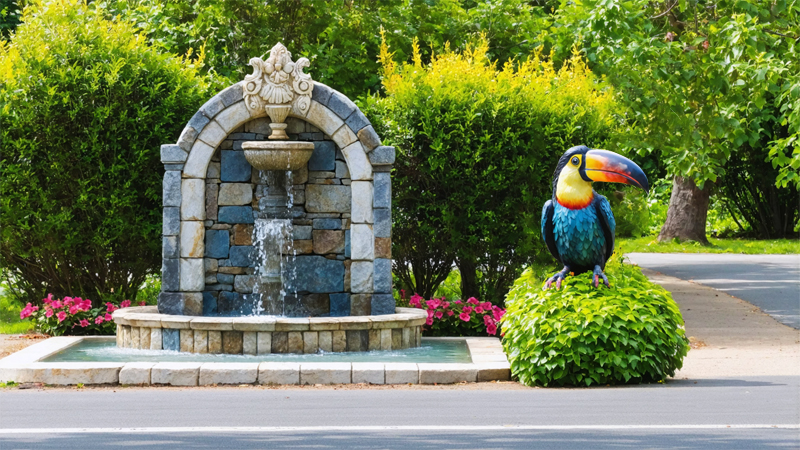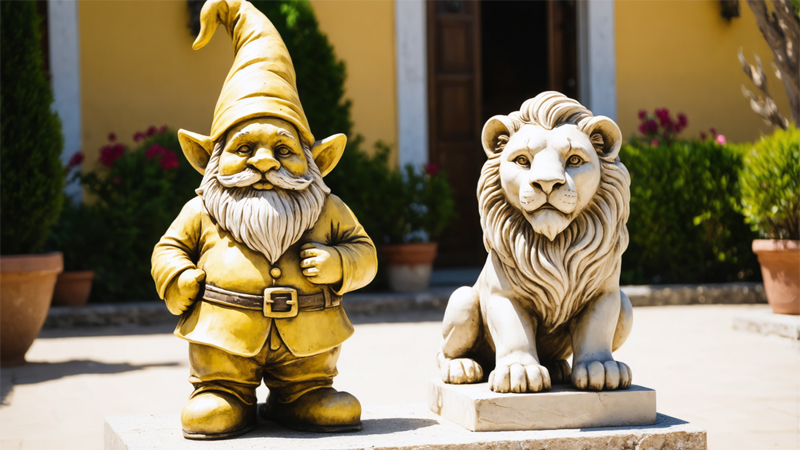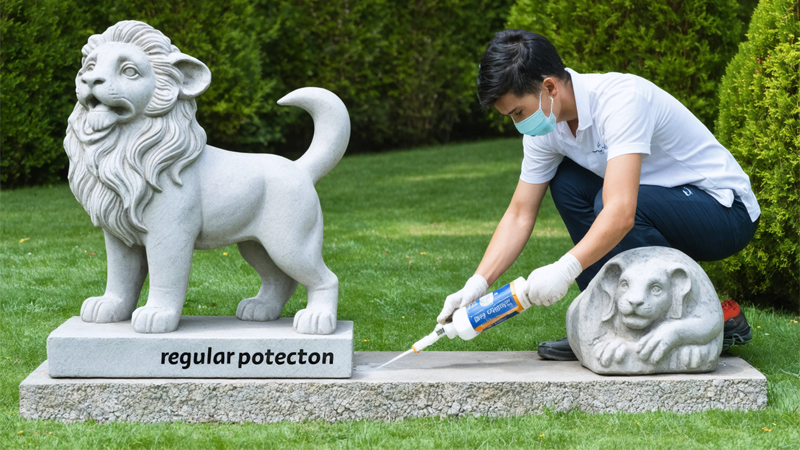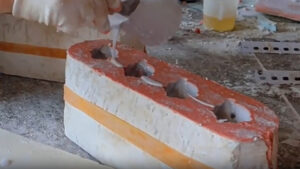
Choosing the perfect statue material can transform your space, balancing beauty with functionality.
Resin and stone statues differ significantly in aesthetic qualities, durability, cost, and maintenance, each offering unique advantages for various settings.
Let’s delve into the key differences between resin and stone statues.
How do the aesthetic qualities and textures compare?
Have you ever noticed the distinct look and feel between resin statues and stone statues?
Resin statues offer a smooth, glossy finish with vibrant colors and intricate details, while stone statues feature natural textures, earthy tones, and a timeless elegance.

When I first started decorating with statues, the contrast between resin and stone was striking. Resin statues, with their high-gloss finishes, bring a modern and colorful touch to any room. They can be molded into highly detailed shapes, capturing everything from delicate floral patterns to abstract designs with ease. I remember a resin butterfly statue I added to my living room; its vibrant colors and lifelike wings became an instant conversation starter.
On the other hand, stone statues exude a classic and enduring charm. Their natural textures and earthy tones blend seamlessly with traditional and rustic decor styles. The tactile feel of stone, with its rough and uneven surfaces, adds depth and authenticity to outdoor gardens or indoor settings like hallways and foyers. A marble bust I own not only adds sophistication but also stands as a testament to timeless artistry.
Enhancing Visual Appeal
| Aspect | Resin Statues | Stone Statues |
|---|---|---|
| Finish | Smooth, glossy | Natural, textured |
| Color Variety | Extensive, vibrant | Earthy, muted tones |
| Detail Capture | High precision, intricate designs | Subtle, natural variations |
| Style Flexibility | Modern, contemporary, abstract | Classic, rustic, traditional |
Understanding these aesthetic differences helps me choose the right statue to complement my decor. Whether I want a splash of color or a touch of elegance, resin1 and stone2 offer distinct pathways to enhance any space.
What are the durability and weather resistance factors?
How do resin and stone sculptures3 hold up over time and in different environments?
Stone statues are generally more durable and weather-resistant, making them suitable for outdoor use, while resin statues, though resilient indoors, may require protection from harsh weather conditions.

Durability has always been a top priority for me when selecting statues. Stone statues, especially those made from granite4 or marble, are renowned for their strength and ability to withstand outdoor elements without significant wear. I once placed a granite statue in my garden, and despite frequent rain and sun exposure, it remained pristine, its colors and texture unchanged over the years.
Resin statues, while durable, are best suited for indoor environments. They resist impact and are less likely to crack or break compared to ceramic or glass statues. However, exposure to extreme weather can degrade resin over time, causing discoloration or brittleness. To mitigate this, I often place resin statues in sheltered areas or use protective coatings to extend their lifespan outdoors.
Longevity and Maintenance
| Factor | Resin Statues | Stone Statues |
|---|---|---|
| Durability | High indoors, moderate outdoors | Very high, excellent outdoors |
| Weather Resistance | Limited, needs protection | Superior, withstands harsh conditions |
| Maintenance | Low, easy to clean | Moderate, may require sealing |
| Longevity | Good with proper care | Excellent, ages gracefully |
Choosing between resin and stone often comes down to where the statue will be placed and how much maintenance you're willing to perform. Stone statues are ideal for enduring beauty in outdoor settings, while resin statues offer versatility and ease of handling for indoor displays.
What are the cost implications of resin versus stone?
Budget plays a crucial role in selecting the right statue material.
Resin statues are generally more affordable than stone statues, offering cost-effective options for detailed and customizable designs without the high price tag of natural stone.

When I started collecting statues, budget was a significant consideration. Resin statues5, provided an affordable entry point, allowing me to experiment with different styles and colors without breaking the bank. For example, I was able to purchase several resin animal figures that added playful elements to my home without the hefty cost associated with stone counterparts.
Stone statues6, while more expensive, offer long-term value due to their durability and timeless appeal. Investing in a stone statue means acquiring a piece that can last generations, maintaining its beauty and structure over time. A granite sculpture I purchased, though costly upfront, has become a cherished heirloom in my garden, appreciated for its enduring presence.
Cost Comparison
| Material | Initial Cost | Customization Cost | Long-term Value |
|---|---|---|---|
| Resin | Low to Moderate | Low | Good, with maintenance |
| Stone | High | High | Excellent, heirloom quality |
| Ceramic | Moderate | Moderate | Moderate, requires care |
Resin's affordability makes it a popular choice for those looking to decorate on a budget or for artists creating multiple pieces. Stone, while a more significant investment, provides unparalleled longevity and a classic aesthetic that resin cannot match.
What are the maintenance needs for each material?
Keeping your statues in top condition is essential for their longevity and appearance.
Resin statues require minimal maintenance, such as occasional dusting and gentle cleaning, while stone statues may need regular sealing and care to prevent staining and weathering.

Maintaining the beauty of my statues is something I take pride in. Caring for resin statues7 is simple—just a quick dusting with a soft cloth keeps them looking fresh. If they get a bit dirty, a quick wipe with a damp cloth does the trick without any special cleaners needed. This low-maintenance nature allows me to enjoy their beauty without the hassle of extensive upkeep.
Stone statues require more attention8, however. To preserve their natural luster and prevent staining, I regularly apply a sealant, especially for outdoor pieces. This not only protects the stone from moisture and pollutants but also enhances its appearance, keeping it vibrant and free from grime. Additionally, stone statues may require occasional cleaning with mild detergents to remove stubborn dirt without damaging the surface.
Maintenance Checklist
| Maintenance Task | Resin Statues | Stone Statues |
|---|---|---|
| Dusting | Occasional with a soft cloth | Regularly with a brush or cloth |
| Cleaning | Gentle wipe with a damp cloth | Mild detergent wash, avoid harsh chemicals |
| Sealing | Not typically required | Regular sealing to protect from elements |
| Repairing | Minor scratches can be polished | Cracks may need professional repair |
Understanding the maintenance requirements helps me keep my statues looking their best, whether I choose the ease of resin or the timeless elegance of stone. Proper care ensures that both resin and stone statues continue to enhance my space for years to come.
Conclusion
Resin and stone statues each offer unique benefits, helping you choose the perfect piece for your space.
-
The link to"resin statues "link will provide you with insights into their glossy finishes, vibrant colors, and ability to capture intricate details, perfect for modern or colorful decor. ↩
-
the link to "stone statues"link offers a deeper look at the timeless, natural textures and earthy tones of stone, ideal for those seeking a classic, elegant touch in their home. ↩
-
The link to "sculptures" helps you understand the broader category of sculptures beyond just statues, giving you insights into the different material choices available for both indoor and outdoor environments. ↩
-
By linking to "granite," you’ll learn why this material is particularly suited for outdoor sculptures, providing details about its strength and weather resistance, which makes it ideal for statues exposed to the elements. ↩
-
The link to "resin statues" will give you an understanding of why these statues are cost-effective, focusing on the affordability, customization options, and lower production costs compared to stone. It's crucial for you to know the price differences when making a budget-friendly choice. ↩
-
By linking to "stone statues," you can explore why stone statues, despite their higher initial cost, offer lasting value due to their durability and timeless aesthetic. This helps you weigh the long-term investment of stone against the lower upfront cost of resin. ↩
-
The link to "caring for resin statues" helps you understand the simplicity of maintaining resin statues. You can find useful information on how easy it is to clean and protect resin from dust and dirt without needing special products. ↩
-
Linking to "stone statues require more attention" gives you insights into the more involved maintenance process for stone statues. This includes applying sealants and cleaning techniques to ensure the stone stays protected from weather and stains, particularly when placed outdoors. ↩





